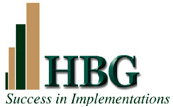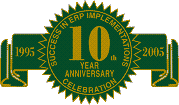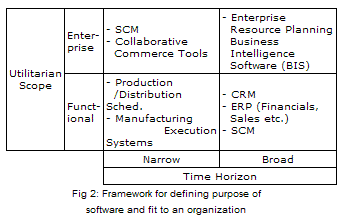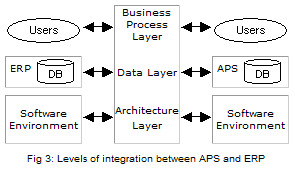 |
Practices For Today's Manufacturing |
 |
| Home | ||
|
Home
|
The ERP-APS Connection
Introduction Today, companies are required to provide ever improving levels of customer service while increasing profitability in order to remain competitive. This is evident with a change in the business model from one of Build-Store-Sell to Sell-Source-Ship that brings the timeline between forecasts and actual orders very close together. This requires companies to satisfy the ever changing customer demands by quickening their reaction times and increasing their effectiveness. In addition, pressure on bottom lines force the adoption of initiatives such as Lean Manufacturing, Just in time Production and Vendor Managed Inventory.Combined, these initiatives aims that companies need to balance. One method of doing so is through detailed adaptable planning and effective quick decision making. Advanced Planning and Scheduling  It is in achieving these objectives that a new genre of software products called Advanced Planning and Scheduling (APS) tools have come of age. These tools provide the organization with the ability to plan and make decisions based on the relative importance of each constraint, namely, profitability, service levels, capacity, human resources, materials and inventory.
These APS solutions can be applied to multiple purposes such as Sales Order Planning, Supply Chain Planning, 'Available to Promise', Transportation Planning, Distribution Network Configuration and Production and Transportation Scheduling. In this particular article we shall limit ourselves to the application of APS principles to Production Scheduling. APS solutions enable organizations to maintain the balance between Capacity Buffer and WIP by planning so as to maintain operations within the optimum operating window with respect to Cycle Times, Resource Utilization and Due Date Performance.
It is in achieving these objectives that a new genre of software products called Advanced Planning and Scheduling (APS) tools have come of age. These tools provide the organization with the ability to plan and make decisions based on the relative importance of each constraint, namely, profitability, service levels, capacity, human resources, materials and inventory.
These APS solutions can be applied to multiple purposes such as Sales Order Planning, Supply Chain Planning, 'Available to Promise', Transportation Planning, Distribution Network Configuration and Production and Transportation Scheduling. In this particular article we shall limit ourselves to the application of APS principles to Production Scheduling. APS solutions enable organizations to maintain the balance between Capacity Buffer and WIP by planning so as to maintain operations within the optimum operating window with respect to Cycle Times, Resource Utilization and Due Date Performance.
APS Compliments ERP  Most ERP systems have in-built planning tools. In addition, the myriad APS offerings each with its own set of core competencies have created confusion with regard to the purpose and hence, the position of APS solutions. ERP act as an integrated execution tracking system with planning tools having a horizon of weeks/months/years. ERP's built in planning tools have one or more shortcomings such as the assumption of Infinite Resources/Long Run Times/Lead Times proportionality to volume/'All customer are equal' premise. APS solutions overcomes these shortcomings and enables accurate quick scheduling in a horizon expressed in minutes/hours/weeks. There is a natural link between scheduling and execution tracking systems and hence, APS and ERP solutions. Moreover , APS solutions can also coexist with other execution tracking systems such as Time Attendance systems (TAS) and Manufacturing Execution Systems (MES).
Most ERP systems have in-built planning tools. In addition, the myriad APS offerings each with its own set of core competencies have created confusion with regard to the purpose and hence, the position of APS solutions. ERP act as an integrated execution tracking system with planning tools having a horizon of weeks/months/years. ERP's built in planning tools have one or more shortcomings such as the assumption of Infinite Resources/Long Run Times/Lead Times proportionality to volume/'All customer are equal' premise. APS solutions overcomes these shortcomings and enables accurate quick scheduling in a horizon expressed in minutes/hours/weeks. There is a natural link between scheduling and execution tracking systems and hence, APS and ERP solutions. Moreover , APS solutions can also coexist with other execution tracking systems such as Time Attendance systems (TAS) and Manufacturing Execution Systems (MES).
In this particular article we shall limit ourselves to the Production Scheduling as defined by APS principles. APS solutions enable organizations to maintain the balance between Capacity Buffer and WIP so as to maintain operations within the optimum operating window with respect to Cycle Times, Resource Utilization and Due Date Performance. APS and ERP Integration Integration between the two software is very rarely the same across organizations, because of the differences in the software operating environment, the manufacturing process or the way in which time is recorded and understood (minutes/seconds/hours). There are, however, certain common aspects to integration implementations namely, Architectural, Data, Business Processes and Operating Procedures. Architecture Strata  Decisions at this level of integration concern the system architecture of the data transfer mechanism. There are primarily three architectures:
Decisions at this level of integration concern the system architecture of the data transfer mechanism. There are primarily three architectures:
Data Strata There are two aspects to integrating at this level. These are how the data will be moved from one system to the other, and what data in what form will be moved across. The simpler of the two decisions involves data transportation and requires the definition of how the data will physically move from one system to the other. Examples include File Structures, Internet, FTP etc. and will also include the definition of security, completeness and accuracy procedures. The answer to the other question forms the bulk of the integration process and involves mapping data from one system to the other taking into consideration issues such as data focus, metadata compatibility, data synchronization and data dimensions. Business Process Strata At the business process level the integration will focus on defining the tasks performed on each of the systems, the linkages between the tasks and the division of responsibilities while ensuring process continuity. Additionally, the operational directives for the integration program such as responsibility and frequency also need to be defined for both Master and Transactional data. Operating Procedure Strata This is the final piece of the puzzle and requires the definition of actual times and events that trigger the data transfer process. Also essential are the monitoring procedures such as the periodicity of review of log files. ~ Case Study: PRMS Integration with Asprova Single Vendor It is true that using a single vendor will require less effort in terms of integrating the two solutions. However, in addition to integration, there are a number of issues that need consideration prior to deciding on an APS solution provider. The benefits of some of these in terms of flexibility and future cost savings may offset the cost downside of integration.
Conclusion APS solutions have proven their capabilities in improving an organization's ability to continuously improve its service levels in a cost-effective manner and hence are essential components of any organization's software architecture. The success of the implementation, measured by results, is greatly influenced by both the suitability of the APS package to the organization and the successful integration of the APS solution into the ERP backbone. |
|
| Contact us at: 1-800-263-0193 | Copyright © 2004 Hunter Business Group Inc. All Rights Reserved. |